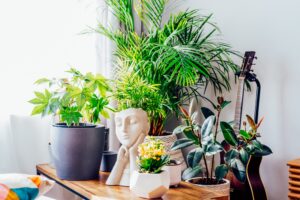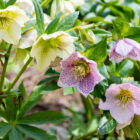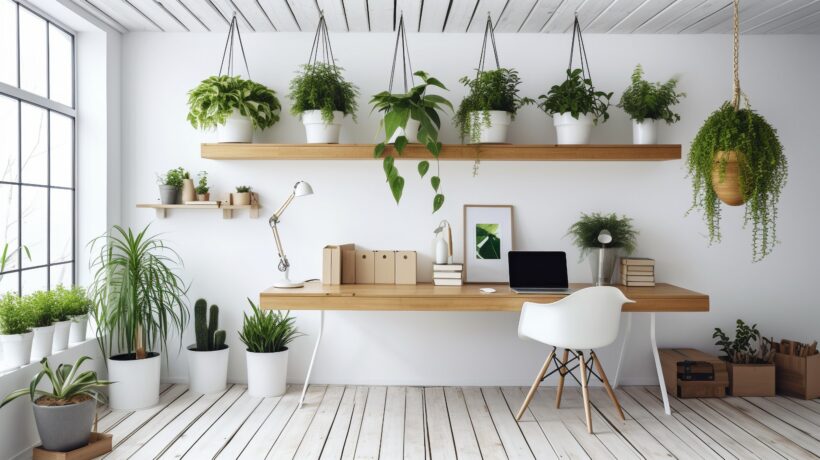
Indoor plants, how to care for them properly?
How do you take care of indoor plants?
Many indoor plants come from tropical regions, so they require a pleasant environment at home. As well as needing oxygen, water and light, they also require the right amount of humidity in the air and good fertilisation. In addition, even pests and fungal diseases may attack them. Therefore, in this article you will find all the information and tips on how to make your houseplants and/or plants grown in other domestic environments grow healthily and vigorously.
Indoor plants for green spaces
However, a distinction must be made between green plants and flowering plants. Green plants such as monstera, yucca, ficus, succulents, cacti, and bonsai adapt perfectly to the interior of our homes. The development of plants depends on various factors, such as location, room temperature and, of course, care.
Flowering plants
Flowering plants provide a touch of colour all year round in our rooms. These include orchids, anthurium, begonia, spathiphyllum and many others. In particular, these plants brighten up days at home when it is raining or cold outside. As with plants with green leaves, plants with flowers also need a regular care and fertilisation to ensure their good growth and well-being.
Indoor plants and humidity
Indoor plants not only decorate our homes impeccably, they also create a very pleasant indoor climate.
Air-purifying indoor plants
These are plants that not only regulate humidity and produce oxygen but also capture substances that are harmful to health such as benzene, cigarette smoke and other pollutants. These include ficus benjamin, aloe vera, dracena marginata and ivy helix.
How to care for plants?
You can purchase these elegant plants to decorate and embellish home interiors. However, they grow differently from those that live in the wild. Therefore, these will have to adapt to smaller spaces and special environmental conditions. For this reason, it is important to choose plants that can adapt to the new conditions. Furthermore, taking care of plants brings many benefits on a psychological level. Actually, they are ideal for those suffering from anxiety, depression or dementia. Furthermore, plants help to purify the air in indoor spaces thanks to their photosynthetic action. Since there are so many varieties of indoor plants in existence, it is very difficult to describe the specific needs of each one. Therefore, in this article you will find some guidelines, to integrate depending on the type of indoor plant.
Plant placement – which is the right one?

The location of plants is crucial and each plant has its own favourite. An indispensable element for chlorophyll photosynthesis to take place is light. In particular, it is an important element because it lets the plant to perform its vital functions. In fact, not all plants like the same location. For example it is preferable to not expose plants such as monstera deliciosa, yucca, Spathiphyllum, schefflera, and zamioculcas to direct sunlight.
On the other hand, cactus, some palm tree species, among them the fan palm tree, the ficus lyrata, and some flowering plants tolerate a brighter exposure. While others like a shady location. These include the potos, the phalangium and the dracaena. Finally, there are those that prefer a shady position and a humid environment, such as ferns and sansevieria. Therefore, the latter are ideal for decorating bathrooms.
How and when to water plants?
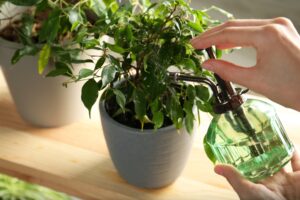 Also in terms of watering, each plant species has its own requirements. There are plants that only need water moderately when the substrate is dry. These include the snake plant, aloe vera, silver and golden pothos, ficus elastica, tiger tongue and lavender. It is advisable, before watering the plants, to carry out a finger test. Then there are plants such as orchids, which generally need a root bath with lukewarm water. When watering orchids, it is preferable to add a specific fertiliser. Then there are those that like sprinkler irrigation. We are talking about ficus, some palm tree species and ferns. Watering should be done especially during the summer season when it is hot, and during the winter only if the heating is very high. Conversely, if plants are in cold rooms during the winter period, it is advisable to reduce watering. Avoid water stagnation, which can cause rottenness.
Also in terms of watering, each plant species has its own requirements. There are plants that only need water moderately when the substrate is dry. These include the snake plant, aloe vera, silver and golden pothos, ficus elastica, tiger tongue and lavender. It is advisable, before watering the plants, to carry out a finger test. Then there are plants such as orchids, which generally need a root bath with lukewarm water. When watering orchids, it is preferable to add a specific fertiliser. Then there are those that like sprinkler irrigation. We are talking about ficus, some palm tree species and ferns. Watering should be done especially during the summer season when it is hot, and during the winter only if the heating is very high. Conversely, if plants are in cold rooms during the winter period, it is advisable to reduce watering. Avoid water stagnation, which can cause rottenness.
Potting soil for plants – which one is most suitable for indoor plants?
Of fundamental importance is the growing substrate. In fact, it has the function of storing water and nutrients that will then be released to the plant. For indoor plants there are many soils that can be purchased at the garden centers. For example compost, bark humus or coconut/wood fibre. However, it is advisable to buy a soil specific for the plant. For example, for orchids it is preferable to use the bark. This soil provides them with everything they need for healthy growth.
Repotting: when is the right time?
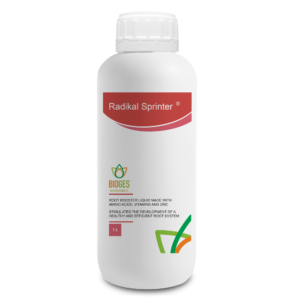 Indoor plants require repotting when the pot starts to become too small. This problem mostly happens when the roots stick out of the drainage hole at the bottom of the pot. It is also necessary when the soil is lacking essential nutrients. In fact, if you do not act promptly, the plant begins to show the first signs of malaise. The best time to repot plants is in spring, every 2-3 years. Finally, to avoid repotting stress, it is best to use a liquid rooting agent such as Radikal Sprinter. If you follow these steps, the plant will continue to grow healthy and vigorous.
Indoor plants require repotting when the pot starts to become too small. This problem mostly happens when the roots stick out of the drainage hole at the bottom of the pot. It is also necessary when the soil is lacking essential nutrients. In fact, if you do not act promptly, the plant begins to show the first signs of malaise. The best time to repot plants is in spring, every 2-3 years. Finally, to avoid repotting stress, it is best to use a liquid rooting agent such as Radikal Sprinter. If you follow these steps, the plant will continue to grow healthy and vigorous.
Indoor plant pot
The choice of pot is important not only for the growth and wellbeing of plants but also for tastefully decorating rooms in the home. On line but also in garden shops you can buy pots made of different materials, colours and shapes. The most commonly used are terracotta or plastic pots. However, Doctor Bioges does not recommend the use of plastic pots as these do not allow the roots to transpire. There are also those with irrigation, making it easier to maintain and plants care.
Fertilise plants correctly
House plants periodically need a good fertiliser that provides them with all the micro and macronutrients that are essential for their growth and healthy development. The main macro elements are Nitrogen, which not only promotes plant growth but also gives the leaves an intense green colour. Phosphorus, on the other hand, is a macro nutrient that stimulates flowering. While Potassium, strengthens the plant structure, making it stronger to cope with unfavourable conditions. Finally, micronutrients such as iron and magnesium, as well as counteracting leaf chlorosis, strengthen plant resistance. Leaves are indicators of plant health. They can provide us with information on what our plants are lacking. It is therefore important to observe the plants and respond to these signals in good time.
Fertiliser for green and flowering plants – which one to choose?
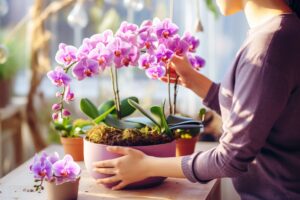 As pointed out, each plant requires these macro and micronutrients in different ratios for healthy growth. The fertiliser that supplies the plant with these nutrients can be liquid, granular or micro-granular. When choosing the fertiliser to be used, it should be adapted to the needs of the plant. For example, if the plant needs a quick boost in terms of growth, it is preferable to use a liquid fertiliser such as Mister Plants Bio, which is also ideal for indoor plants. Alternatively, a water-soluble fertiliser such as VerdeOk can be used, to be administered periodically throughout the year.
As pointed out, each plant requires these macro and micronutrients in different ratios for healthy growth. The fertiliser that supplies the plant with these nutrients can be liquid, granular or micro-granular. When choosing the fertiliser to be used, it should be adapted to the needs of the plant. For example, if the plant needs a quick boost in terms of growth, it is preferable to use a liquid fertiliser such as Mister Plants Bio, which is also ideal for indoor plants. Alternatively, a water-soluble fertiliser such as VerdeOk can be used, to be administered periodically throughout the year.
Stay up to date with our latest gardening news!

